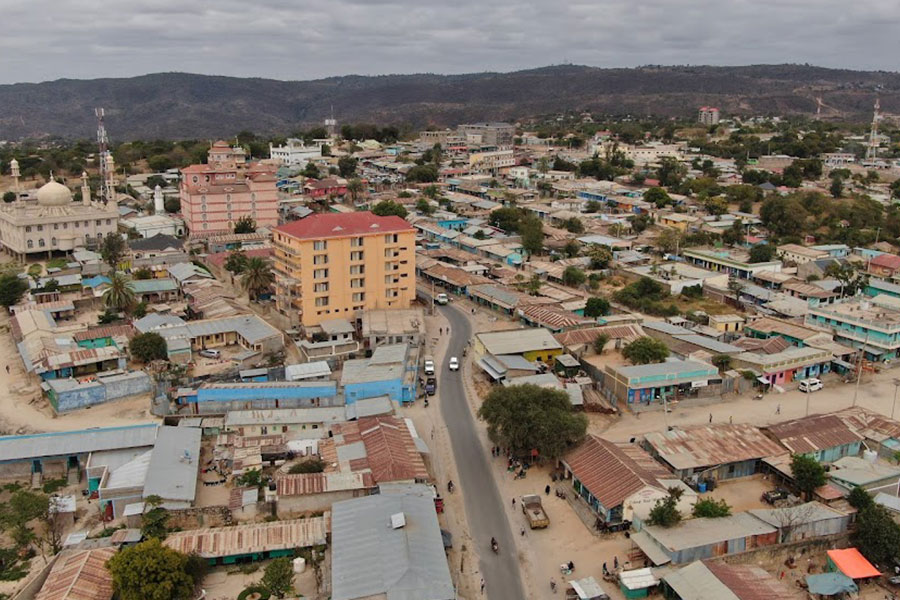
Radar | Dec 04,2022
Dec 21 , 2019
By Yonas Biru (PhD)
The nine billion dollars in development aid Ethiopia is expected to receive, including in concessional loans from the World Bank and IMF, is generous by historical standards and unprecedented for the country. Ethiopia should be grateful. But the package is woefully inadequate to tackle the country’s economic woes in all its dimensions and dislodge it from the low-level equilibrium trap, argues Yonas Biru (PhD) (biruyonas@yahoo.com), former deputy global manager of the International Comparison Programme at the World Bank.
Africa’s economic reform track record is replete with high expectations and shattered dreams running in alternate cycles. After nearly 50 years of revolving reforms of all sorts and hundreds of billions in development aid, Africa has failed to dislodge itself from what the economist Richard Nelson called the low-level equilibrium trap. Africa’s reality remains the same, but the narrative alternates between boom and bust, depending on who tells it.
In 2000, the front page of The Economistmagazine painted Africa as “The Hopeless Continent.” A decade later, the esteemed editors of the magazine went gung-ho happy hunting and declared “Africa Rising.” Eighteen months later, came another front-page hoopla, heralding and splashing “Aspiring Africa” in technicolor.
In 2016, McKinsey & Company released a glowing report titled “Lions on the Move” narrating Africa’s economic performance as a metaphorical prelude to an era that will rival Asia’s growth path that was trailed by Asian “dragons and tigers” and Latin American “jaguars.” Alas, Africa, we were told, was “emerging” as in emerging nations.
Africa’s story depends on who is telling it and why rather than what needs to be told. In 2000, the year The Economistbranded Africa “hopeless” and condemned it with a dismissive line "the world might just give up on the entire continent," the World Bank painted a hopeful and capable continent that can claim the 21st century. This was in a report titled “Can Africa Claim the 21st Century?” The question was affirmatively asserted with an assortment of caveats.
Each depiction has a grain of the proverbial truth. For The Economist, the grain was Sierra Leone. Since the difficulties facing Sierra Leone “seemed so intractable, and since Sierra Leone seemed to epitomise so much of the rest of Africa," the entire continent was reduced to a state of hopelessness.
The grain in the World Bank’s report that was twisted and hammered until it confessed the proverbial truth was the art of generalisation fortified with an overdose of "must do" and "should do" prescriptions of an impossible reform agenda to justify the wishful prospectus. For example, “to succeed in the 21st century”, the report stated, “Africa has to become a full partner in the global economy."
The fact is Africa - bar South Africa - has little say in becoming a “full partner in the global economy.” Its virtual absence in the G-20 is a case in point. The G-20 is a fraternal society for the affluent and affluent-to-be that “promotes open and constructive discussion between industrial and emerging-market countries on key issues related to global economic stability."
Poor African countries are invited as observers to hear others discuss the global economy, as if they are visitors from Mars. Yet the World Bank expected them to claim the 21st Century.
If one dares to peel off the surfaces of The Economist’sand the World Bank’s reports and dares to peek into the story behind the story, one would find the same proverbial grain sprouting into two contradictory narratives. To do that one needs to look into what happened in 1994.
The year 1994 was the 50th anniversary of the World Bank and the IMF. It was also the year the “50-Years is Enough” global campaign was birthed. The campaign set off an avalanche of research that led to a growing body of consensus on the chronic failure of Africa to shake off its poverty-stricken image, despite hundreds of billions in development aid.
The Economist’spessimism was a reflection of the manifested frustration of donor nations who saw no reason to continue funding the development efforts of a continent that was showing no sign of development. Between 1990 and 2000, the GDP growth for Sierra Leone was negative 2.2pc. The average for Sub-Saharan Africa was a meagre 2.2pc on the positive side of the ledger. The continent’s population growth was 2.7pc during the same period.
Not surprisingly, the World Bank’s report came at a time the institution’s track record was under relentless attack, not only from the right but also from the left. Its flagship report was a rallying cry for continued support, understandably with a glaring prospect of Africa claiming the century. It was sprinkled with high hopes and grounded in unattainable dreams. It was part shazamand part abracadabra.
Fast-forward to 2011, 2013 and 2015 and take a closer look at the narratives painting Africa as “Rising”, “Aspiring” and, above all, as roaring “lions on the move.” This time around, the trick was picking a few countries that were performing reasonably well, such as Ethiopia and Rwanda, and extrapolating their realities into a trend for continental Africa.
The average GDP growth for Sub-Saharan Africa between 2001 and 2011 was 5.3pc. The growth for the period between 2001 and 2015 was slightly lower at five percent. Though reasonably good, it was nothing to write home about, considering poor countries are expected to grow much faster than rich ones, because they are starting from a lower baseline.
Add to this the seemingly constant 2.7pc population growth and you will see how fast the positive narrative starts to blink. This did not stop McKinsey & Company from extracting the “lions on the move” storyline out of it.
By comparison, the average GDP growth rates for East Asia (excluding high income countries) between 2001 and 2011 and 2001 and 2015, respectively, were, 9pc and 8.5pc. Bring the 0.8pc population growth into the development calculus and it is easy to see the Asian “dragons and tigers” metaphor as a deserved depiction of the continent’s development. The corresponding GDP growth rates for South Asia was 6.3pc in both periods coupled with a 1.6pc population growth. This may not qualify the sub-continent as a fire-spitting dragon. But it sure portrays it as a limping tiger, considering the consistency in its performance.
I have provided an explanation for the observed difference between Asia and Africa in an article headlined “PM’s Vision Is Like a Ferrari With Borrowed Engine” in the October 5, 2019 issue of this newspaper.
Let us zoom in on Ethiopia, arguably the top performer in Africa, registering strong recovery and dramatic growth rates between 2001 and 2015. But beneath the lustre of encouraging performance lie a host of challenges. To speak of the economic challenges only, the country’s growing income inequality, exacerbated by unsustainable and increasingly bulging youth unemployment, tops the “God forbid” category of lurking problems.
To top it off, Ethiopia has underdeveloped financial institutions and markets, including banking and capital markets, starving the entrepreneurial class of access to credit and stifling the private sector from becoming the engine of growth and employment. Add to these low productivity sectors, including agriculture and industry and the chronic shortage in foreign exchange to import capital goods (machine tools) and technology. That explains the proverbial unbudging stonewall Ethiopia must break through before the “lion on the move” can advance forward.
Consider, too, the 2.8pc population growth and there emerges a country with an impressive average economic growth of 9.2pc between 2001 and 2015 inextricably entangled with under development, if not chronic poverty. If this is the case with the continent’s best performer, it behooves us to ask the question: “Is there any hope for the continent to break out of Nelson’s low-level equilibrium trap?"
Africa’s track record of the last 50 years fails to inspire confidence unless there is a paradigm change in its reform regime. Ethiopia is best positioned to introduce a bold paradigm shift in its reform regime and manage to rally the donor community to help fund it.
The country is at a watershed moment. National and international factors are aligned in its favor. Nationally, the ongoing reform, though limited in breadth and depth, enjoys broad political support. Internationally, multilateral and bilateral funding agencies not only support the reform agenda but are also generously footing the bill.
The nine billion dollars in development aid Ethiopia is expected to receive, including in concessional loans from the World Bank and IMF, is generous by historical standards and unprecedented for the country. Ethiopia should be grateful. But the package is woefully inadequate to tackle the country’s economic woes in all its dimensions and dislodge it from the low-level equilibrium trap.
Ethiopia needs to avoid the all too familiar revolving reforms and develop a new strategic and bold reform paradigm to build a critical mass of complementary reforms. Its international partners are likely to support it with preferential interest, provided it is shown to create a robust and transformational development and arouse confidence and trust to make Ethiopia an anchor for regional security and stability. For the policy wonks among us, the case for a preferential development assistance to Ethiopia has been made before in these pages [ VOL 19 , NO 974].
PUBLISHED ON
Dec 21,2019 [ VOL
20 , NO
1025]


Radar | Dec 04,2022

Radar | Dec 04,2022

Fortune News | May 07,2022

Radar | Jun 30,2024

Radar | Aug 21,2021

Radar |

Radar | Dec 25,2023

Commentaries | Jul 17,2022

Radar | Aug 05,2023

Commentaries | Oct 28,2023

My Opinion | 132105 Views | Aug 14,2021

My Opinion | 128507 Views | Aug 21,2021

My Opinion | 126435 Views | Sep 10,2021

My Opinion | 124046 Views | Aug 07,2021





Dec 22 , 2024 . By TIZITA SHEWAFERAW
Charged with transforming colossal state-owned enterprises into modern and competitiv...

Aug 18 , 2024 . By AKSAH ITALO
Although predictable Yonas Zerihun's job in the ride-hailing service is not immune to...

Jul 28 , 2024 . By TIZITA SHEWAFERAW
Unhabitual, perhaps too many, Samuel Gebreyohannes, 38, used to occasionally enjoy a couple of beers at breakfast. However, he recently swit...

Jul 13 , 2024 . By AKSAH ITALO
Investors who rely on tractors, trucks, and field vehicles for commuting, transporting commodities, and f...

Jul 12 , 2025
Political leaders and their policy advisors often promise great leaps forward, yet th...

Jul 5 , 2025
Six years ago, Ethiopia was the darling of international liberal commentators. A year...

Jun 28 , 2025
Meseret Damtie, the assertive auditor general, has never been shy about naming names...

Jun 21 , 2025
A well-worn adage says, “Budget is not destiny, but it is direction.” Examining t...

Jul 13 , 2025 . By YITBAREK GETACHEW
The Addis Abeba City Revenue Bureau has introduced a new directive set to reshape how...

Jul 13 , 2025 . By BEZAWIT HULUAGER
Addis Abeba has approved a record 350 billion Br budget for the 2025/26 fiscal year,...

Jul 13 , 2025 . By RUTH BERHANU
The Addis Abeba Revenue Bureau has scrapped a value-added tax (VAT) on unprocessed ve...

Jul 13 , 2025 . By NAHOM AYELE
Federal lawmakers have finally brought closure to a protracted and contentious tax de...